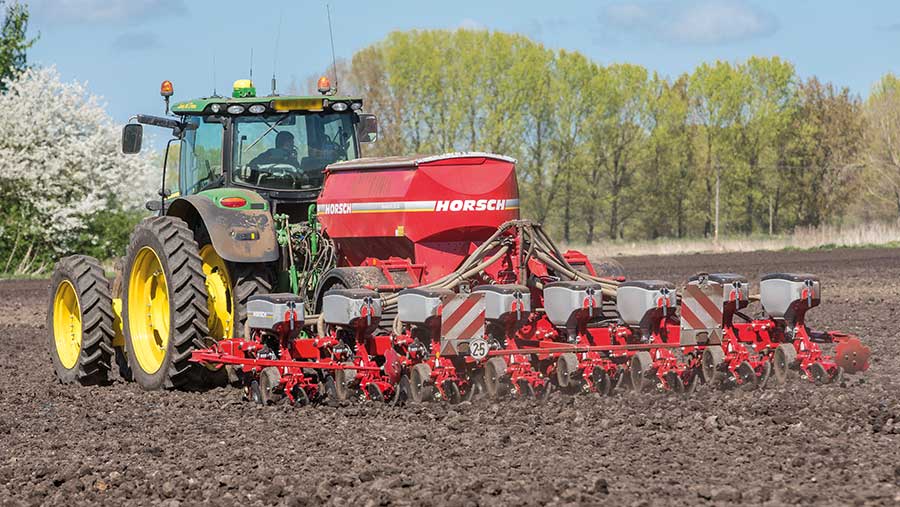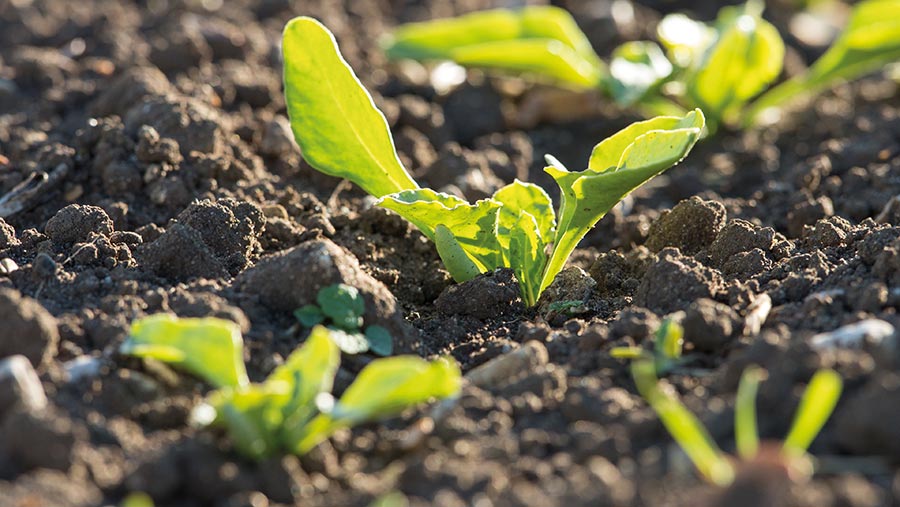Crop Watch: Winter barley races away and late start to maize
 © GNP
© GNP April turned out to only be marginally better than March, prolonging the struggle to get spring crops drilled and keep on top of spraying.
But while field work progress has been slow, winter barley has raced away through its growth stages with many crops having the flag leaf fully emerged.
North
Patrick Stephenson
AICC (Yorkshire)
To date, we have had a very unkind spring with farmers and agronomists in peak grumpy mode. Cold wet conditions have led the countryside to resemble a hotchpotch of off-green colours.
Despite the slow spring, winter barley crops have won the race to be the most advanced, with many crops now having flag leaf fully emerged. Sadly, some of these crops have received no agronomic input other than nitrogen this spring.
A rapid re-think of input strategy is being made across many crops with a witch’s brew of inputs being planned. It is quite ironic that in some cases the management is on track, especially where the crops are on light land and the second growth regulators are now being applied with a holding fungicide spray.
See also: Regenerative agriculture: What to avoid and how to start
Spring barley crops are in varying states of emergence and establishment. Early drilled crops will be due a herbicide and potentially a fungicide.
In terms of disease control in spring barley, I treat early drilled crops as higher risk and look at a two-spray approach. The late drilled crops are managed much more on a wait-and-see basis.
Winter wheat crops are at all stages, but for most T1 will now be being applied. At the risk of giving the wrong message, if you are using good eradicant chemistry, I would suggest being slightly late with T1, covering some of leaf two, as better than being too early.
Septoria
Stories of biblical amounts of septoria have been flashed over social media and there is certainly a lot there. In my opinion, spending excess amounts on fungicides now is not cost effective. Varieties with poor septoria ratings will have a robust rate of fluxapyroxad and mefentrifluconazole as their core treatment.
I am not of the belief that piling more chemistry on now is the best use of resources. If the wet weather continues and leaf two emerges, I might consider a cost-effective multisite product.
If I was going to make a horror film this year, it would be called Torture by Oilseed Rape. I feel as though flowering has been happening for months, with still no end in sight. Flea beetle, cold wet weather and pigeons have devastated many crops. What looked like good crops all winter, now look like a nuclear wasteland.
On a positive note, it has been too cold for sclerotinia. The remaining good crops will have a fungicide shortly, but scrutinising the AHDB fungicide performance curves, this is likely to be an inexpensive intervention. It would be very easy to write a column on what insect pests we can no longer guarantee good control of in all crops, but rape has more than its fair share.
Another example of this is the control of seed weevil and pod midge. Products available have poor efficacy and it is very hard to justify any attempted intervention.
Flowering has just started in the winter beans, with chocolate spot evident everywhere. Unfortunately, delaying a fungicide is not an option this year and with strobilurins restricted to two applications in the season, I will start with the ever-present tebuconazole.
Pea and bean weevil are active in spring beans but very variable. I would only consider intervention if damage was limiting growth, as unfortunately successful control is limited.
Winter oats, having looked magnificent all year, now resemble all the red hues imaginable. Wet conditions and sulphonyl urea herbicides have combined to brighten the countryside. Here’s hoping they grow away quickly!
Overall, the countryside looks like a day-after hangover. Let’s hope that warm and dry weather returns, and my June column has better news.
South
Oliver Bennetts
Zantra (Kent)
Over the past month field jobs have been tricky, to say the least, with both wind and rain making spraying and applying fertiliser virtually impossible. With April only marginally drier than March it’s a totally different picture in the South East compared with last spring.
Normally we would see rust by now, but due to the cold wet weather, septoria has taken its place with signs of movement within the canopy.
T1 sprays are being applied as and when conditions allow – farmers are keeping on top of spraying as best they can. I’m sure that some may have been applied either a little early or slightly later than the ideal.
With a mix of SHDI, azoles and a multisite, it has been important to maintain rates in line with the increased pressure from septoria. However, despite the weather, crops are looking well and are growing steadily, with some slightly sunnier and warmer days in the forecast.
A robust plant growth regulator has been included in the T1 mix to help reduce lodging. The catchy weather prevented some T0 applications, so in some cases T1 treatments were a merger of both. Elsewhere, a later PGR treatment will be needed at T2.
Winter barley crops are racing through growth stages with flag leaves out in most crops and the awns just starting to become visible. It won’t be long before the final ear application, based on a strobilurin, azole and folpet mixture to cover rust, net blotch and ramularia.
Spring crops
Some fields drilled in the dry in February are growing well and tillering. However, there are a lot going in as I write this and some still yet to go in. With such varied window of drilling, harvest maybe tricky logistically. Spring barley is now the only cereal option if any sort of yield is wanted.
Peas have been drilled over the past week or so due to wet, cold soils holding drilling up. But these are now chitting and should be emerging soon. What they really need now is some warm, dry weather to really get going.
Maize land has been cultivated and prepared over the past couple of weeks and some fields are being drilled where they can get on.
Potatoes have been a struggle to get in, with rain seemingly coming every other day, so planting progress is very slow.
West
Gavin Burrough
Pearce Seeds (Dorset, Hampshire and Wiltshire)
What few dry days we have had have allowed some field work to be caught up on, although there is still plenty to do.
Hopefully, all spring cereals have now been drilled although a lot went into the ground in the second half of April so are well behind the ones drilled in February, the earliest of which are approaching stem extension.
Wild oats in spring barley will be taken out early if possible, with fenoxaprop-p-ethyl, but make sure that the crop is not stressed before spraying. These early drilled crops should have had all of their nitrogen and sulphur applied by now. Application rates of nitrogen for the later drilled spring cereals will be reduced slightly.
Some spring barley fields have had a large flush of broad-leaved weeds come through and are being targeted with an earlier-than-usual broad-leaved weed herbicide. Other fields have stayed relatively weed-free so far, so will be targeted at the usual T1 timing.
Oilseed rape crops are flowering well and look pleasing in the sun. Where seed weevil have been found at or above threshold levels, they will be treated for using tau-fluvalinate. Sclerotinia fungicides will also be planned for.
Barley
Winter barley crops are on the whole growing well. Some more forward/taller crops will have a late growth regulator applied, especially where the fields were not rolled earlier in the spring due to wet ground conditions in March. Fields which lie wetter are still struggling, especially where first nitrogen applications did not happen until April.
The majority of T1 fungicides in wheat have been applied when there have been breaks in the weather. A number of what few dry days we have had have been frustratingly too windy to consider spraying.
Spring herbicide activity will be tested this year where applications have been delayed and weed sizes are larger than they should be. This is far from ideal, especially on tougher weeds such as corn marigold which is a pain in some fields. Weed control will be monitored even more so in these situations.
Maize seed drilling has now started, probably a good 10 days later than usual. We need to wait for soils to be warm enough before drilling. A minimum of 8C, ideally 10C and rising for 3-4 consecutive days.
The prospect of no bird-deterrent maize seed treatments being available for next spring is a big concern, especially as maize is a very important crop in the South, being used for forage, grain and anaerobic digestion.
At least there will be plenty of soil moisture available this spring to help any pre-emergence herbicides.

© Tim Scrivener
East
Marcus Mann
Frontier (Essex)
The season continues to be challenging, with saturated soils and limited ideal spray days. The high rainfall received within the East significantly delayed spring drilling, with a few heavy, wet lying fields still not dry enough to travel.
Given that we are now in early May, cropping options are becoming limited. I am now actively looking at summer cover crop options to ensure an early entry into an autumn crop next season.
Wheat crops are in the process of having T1s, with only the later-drilled crops still not quite at the correct growth stage. Septoria remains the main disease present, with levels very much dependent on variety and drilling date.
The frosts earlier in the year suppressed levels of yellow rust. However, the disease can be found on susceptible varieties, particular where it has not been possible to apply a T0.
As attention shifts to the all-important flag spray, recommendations will need to take into account the continued unsettled weather and the need to protect the key yield-forming leaves.
Alongside disease control, canopy management will remain important, particularly if the early PGR split was missed. We have had good nitrogen utilisation this year which in turn has created large biomass with a higher yield potential.
Late growth regulation options are available, but be mindful around timing if intending to mix with T2 chemistry, as some products have a cut-off of growth stage 37. Best to separate, to avoid compromising the key timing of the T2 fungicide (65% of yield comes from this leaf and the ear).
Winter barley disease
Unsurprisingly, with the recent wet conditions, winter barley crops are expressing high levels of rhynchosporium, as well as brown rust, particularly in a number of hybrid varieties. It is worth monitoring, particularly if the T1 timing was late and ensuring T2 recommendations take into account the increasing threat.
Sugar beet planting has been sporadic, with a lot going in late April. Fortunately, unlike last year, seed-beds are reasonable with good moisture levels leading to even emergence.
Pre-emergence herbicides have been important to gain early control of broad-leaved weed flushes, allowing for a larger, stronger beet plant ahead of post-emergence contact herbicide applications.
For sugar beet that was not seed treated with Cruiser, the recent Rothamsted forecast has reported peach potato aphid migrations expected around 22 April with 67% incidence of virus yellows – another reason to ensure early nitrogen and nutrient applications to help support the plant reach the tolerant growth stage to virus yellows of 12-16 true leaves.

